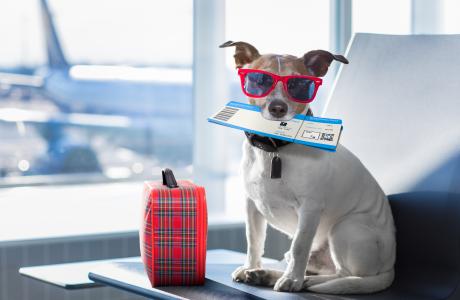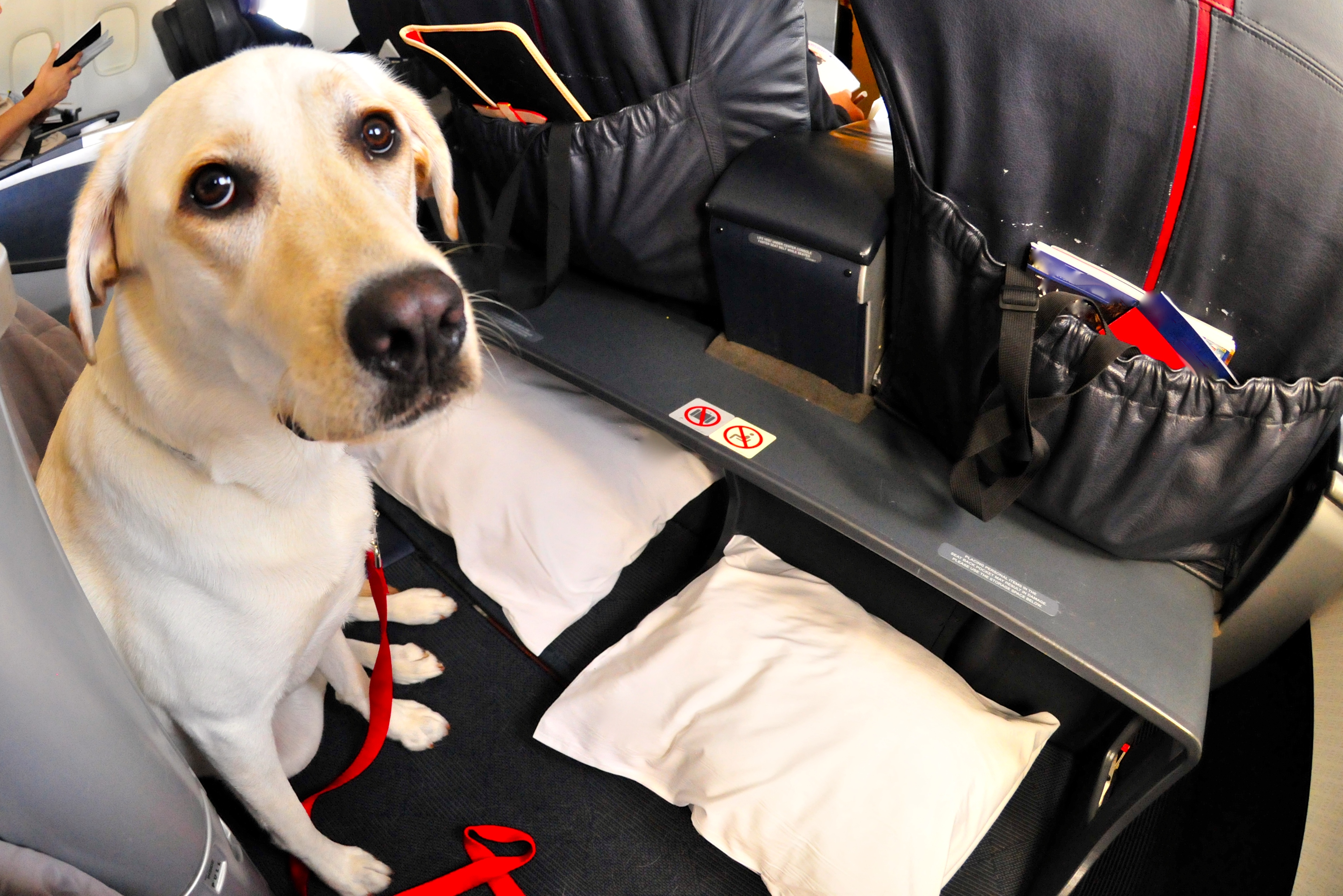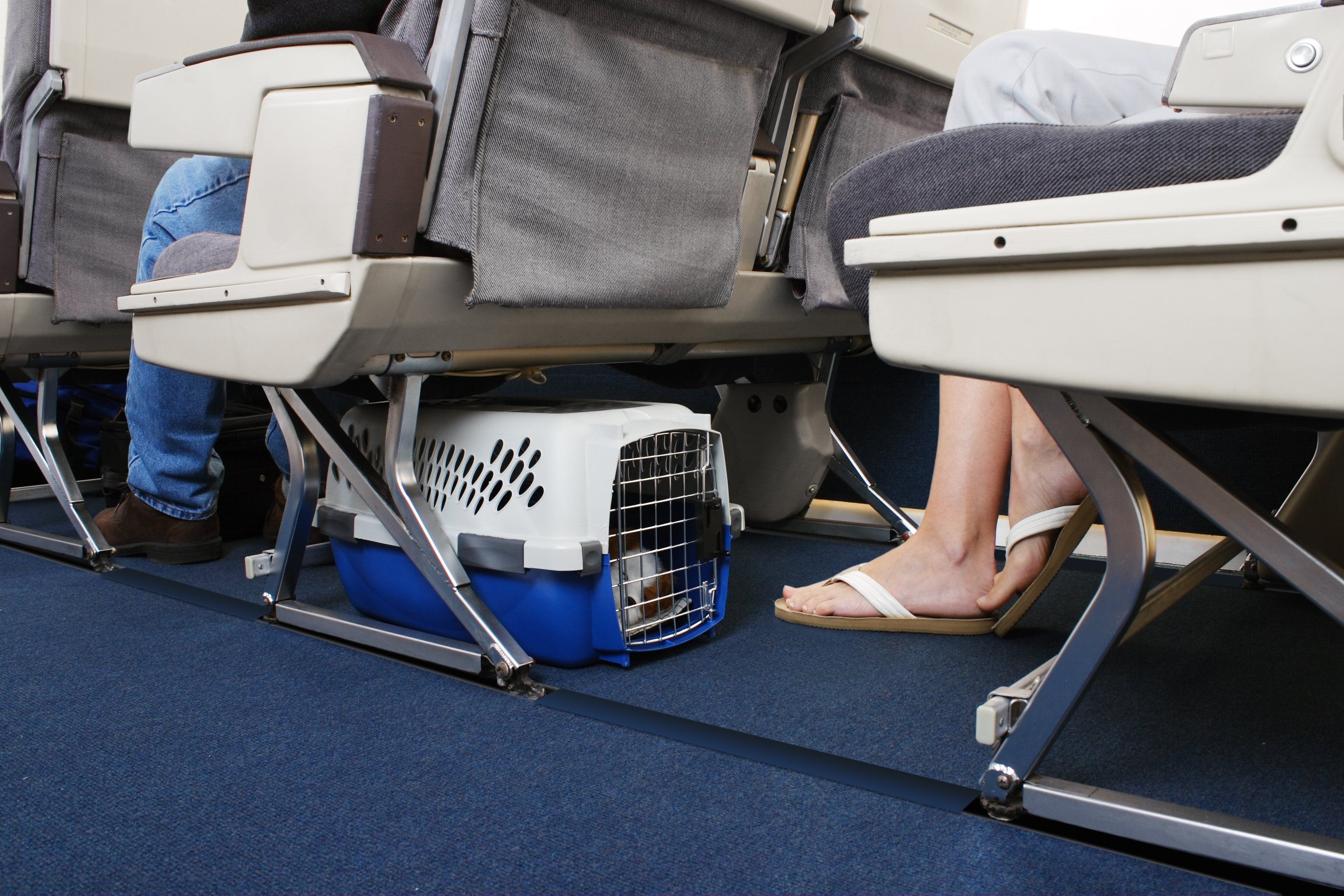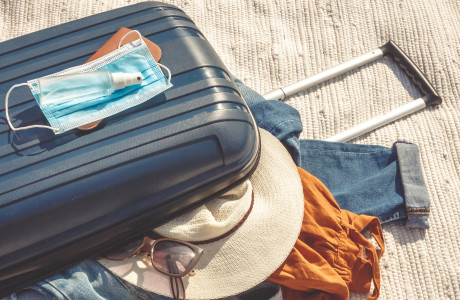
Flying with dogs
Having a dog as a pet is an enrichment in many ways. For many dog owners, there is nothing better than having a loyal soul with a wet nose by your side. Nevertheless, as a dog owner you are often confronted with challenges. For example, when it comes to air travel. Many questions arise: Should I take my dog with me on the plane? What is the procedure for transporting a dog on an airplane? What do I have to consider when booking a flight with a dog? Find out now what is important when flying with a dog.
Contents
Flying with dog: Is my dog allowed on the plane?
Since when flying with a dog the top priority should always be the welfare of your pet and the rest of the passengers, the airlines have fixed and often different conditions regarding the transport of animals. Therefore, you should find out in advance which airline will allow your dog on board. Ryanair, for example, refuses to fly with a dog as a matter of principle. For other airlines, it depends on the weight, size and breed of the dog. For the carriage of small, and therefore usually lighter four-legged friends, there are often less strict requirements than for the carriage of large dogs. These weigh accordingly more and need clearly more place.
Another important factor for flying with a dog is the health and fitness of your four-legged friend. Particularly in the case of blunt-nosed dogs, special measures need to be taken into account, as they are generally prone to respiratory distress and high temperature sensitivity. Such dogs are thus exposed to an additional risk in the airplane, since in addition to the external circumstances or just because of them, the factor stress is added. Therefore, pregnant or very young dogs are usually not transported, and dog owners are strongly advised not to do so. Before you book a flight with a dog, you should therefore clarify whether your dog is "fit to fly" and have this confirmed by your trusted veterinarian.
Tip: If general information on the subject of hand luggage is also interesting for you, please take a look at our article Facts about hand luggage .

Book flights with a dog: What to consider?
If your dog meets the necessary requirements in theory to be allowed on board, it is now necessary to clarify the formal regulations.
Carry out registration
OThe top priority is that you must register an animal transport in advance. Again, the deadlines for registering a flight with a dog vary depending on the airline. However, in most cases this must be completed at least 48 hours before departure. In order to avoid missing these deadlines, you should register your dog at the same time as you book your ticket. Be aware that flying with a dog will incur additional costs depending on the size and weight of your pet.
Check entry requirements
Furthermore, you should inform yourself in time about the entry regulations of your destination regarding flying with a dog:
Chipping:
A now common standard in many countries is that your dog must be chipped to be clearly identifiable.
Pet passport:
In addition, you have to carry an EU pet passport, which informs among other things about the last rabies vaccination. Especially when traveling to Hawaii, Guam or American Samoa, the vaccination should be as fresh as possible, as there are special quarantine obligations for unvaccinated dogs. So keep in mind that a conventional vaccination card is not sufficient if you want to fly with your dog. Therefore, talk to your veterinarian early enough about the issuance of a European certificate.
Leash and muzzle obligation:
Another important entry regulation is whether there is a leash or muzzle obligation for selected breeds or in general.
Liability insurance:
A dog liability insurance can also be useful abroad. In some countries this is even mandatory when flying with a dog.
Quarantine obligation:
In some countries dogs are not allowed to enter easily even with vaccinations. They will be quarantined for a certain period of time. Here they have no contact with other dogs. The time can vary from country to country and is for Australia, for example, at least 30 days.
Tip: If you are unsure about the entry and exit regulations of your vacation country, we advise you to use sources such as the Foreign Office. Here you will find all the important information for an organized flight with dog for any destinations, including country-specific quarantine requirements.
Where will my dog be accommodated on the plane?
Carriage in the cabin
KChecking small dogs on the plane as carry-on luggage is not a problem in most cases. However, they must be carried in a special dog carrier or bag. As long as your own weight in combination with the weight of the box does not exceed a limit set by the airline (usually 6 to 8 kg), your dog can travel on the plane with you in the cabin. Note, however, that the dimensions of permissible dog bags on the plane when flying with a dog may vary depending on the airline. For the flight, the transport container must be on the ground for the entire duration of the flight, and your dog is not allowed to leave the box on the plane. Therefore, before departure, make sure that the container is tightly closed and stable. It is best to additionally write your contact information on the case before flying with your dog or attach an address tag to the box, similar to a suitcase.
Taking along in the cargo hold
Larger dogs are not granted the privilege of traveling together with their owner in the cabin. Instead, they are loaded in the cargo hold in special transport boxes as special luggage. The nature of dog transport boxes on the plane must meet different criteria depending on the airline when flying with a dog and also depends on the breed of dog. For example, dog breeds classified as classic fighting dog breeds, in particular, must usually be transported in cages on which no part may be made of plastic. For just about all large dogs on planes, their crate must be waterproof, ventilated and escape-proof. With your pet's welfare in mind, the crate should also be spacious enough for your dog to lie, stand and turn around in. However, the box must not exceed the specified maximum dimensions.
For guide dogs or therapy dogs, there are exceptions regarding the size of dogs allowed in the cabin. If you are the owner of such an assistance dog, it is best to find out directly from your airline which regulations apply to your dog on the plane.
Tip: Some airlines also offer their own transport boxes, so you do not necessarily have to purchase one for occasional flying with a dog. However, be sure to inquire about the quality of these boxes beforehand. Some airlines are more pet-friendly than others in this regard.

Our tips for preparing for a flight with dog
Traveling by plane is exciting, and this is true for both humans and animals. However, for a dog, this excitement can very quickly turn into stress. Therefore, you should prepare your four-legged friend for the trip early:
Getting used to the transport box
Whether large or small, a transport box is indispensable for flying with a dog. To make it easier for your four-legged friend to remain calm in the strange and noisy environment such as the airplane cabin or the cargo hold, you should set up the box at your home a few weeks before departure. Get your dog used to the transport box by integrating it into his daily routine as a normal basket, and he will recognize it as a place of retreat. In this way, you provide your dog with an important piece of familiarity on the plane.
Properly equip the transport box
Also keep in mind that if you fly with dog, and he travels in the cargo hold, he will not have direct contact with you for a long time. Therefore, it is best to put a personal item such as a cuddle blanket or a T-shirt worn by you in his dog transport box on the plane. Your dog will love to bury his fine nose in it and your smell will additionally calm him down. In addition to personal items, when flying with a dog, be sure to include your contact information in the transport box. Name and phone number are the necessary minimum.
Get some exercise just before the flight
Exercise is good, especially before a long flight. To make sure your dog is less agitated on the plane, don't miss the opportunity to take him for a long walk just before departure. The more tired your four-legged friend is, the higher the chances are that he will quickly calm down and sleep off much of the excitement in his dog crate on the plane.
Sedatives when flying with dogs - yes or no?
Just as every dog on an airplane reacts differently to the unfamiliar environment, reactions to tranquilizers in dogs are often very different. In some cases, the drug does not have a calming effect, but a sedating effect. Your dog can then no longer move, but still gets all the external influences, such as noise or vibrations. This can eventually lead to even more stress and in the worst-case panic. If you decide to fly with a dog, you should consult your veterinarian regarding sedatives. However, in many cases, administering appropriate agents may be useful.
At the end of the day, always keep in mind that you know your dog best and can assess his behavior. Therefore, calmly consider what is best for you and your dog and what advantages as well as disadvantages flying with a dog provides. Basically, every flight for dogs should be thoroughly weighed. Therefore, ask yourself the question in advance: Does my dog absolutely have to take part in this flight or is there another solution?
Whether you end up flying alone or with a four-legged companion - in any case, we wish everyone involved a good trip!



